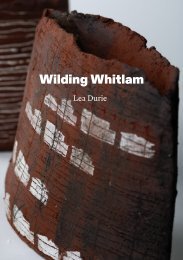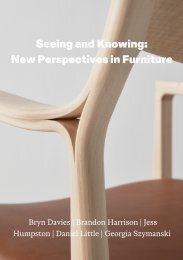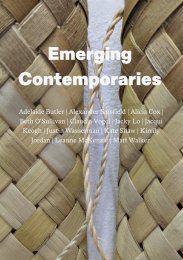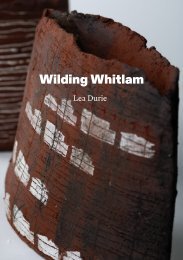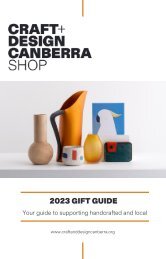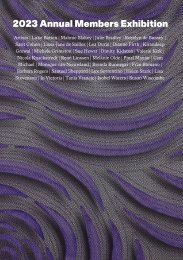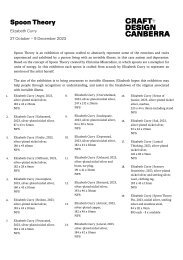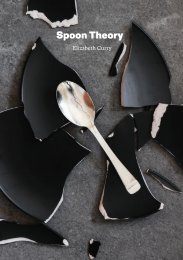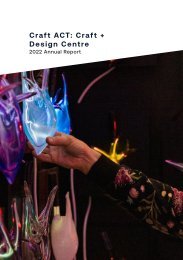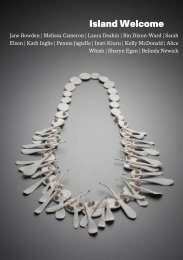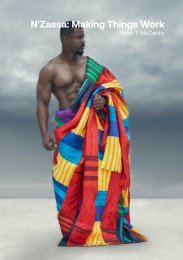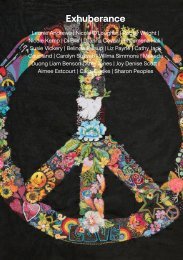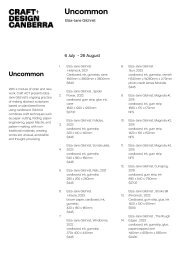Pattern Translation: Al Munro
11 July – 31 August 2019 Solo exhibition by Al Munro* which draws from her recent body of work. The exhibition consists of five pairs of dresses sewn from digitally printed fabrics and paintings. The process by which these pairs of works were produced involved translating textile patterns into painted forms, translating and manipulating these via the conventions of repeat fabric design to create digitally printed textiles/paintings, and then translating back to traditional painted form. Pattern Translation continues Munro's interest in translating and distorting mathematical patterns to explore relationships between textile patterning and painted abstraction and begins a new focus on the aberrations and slippages that can occur as a pattern, like a spoken message, is translated from one ‘language’ to another.
11 July – 31 August 2019
Solo exhibition by Al Munro* which draws from her recent body of work. The exhibition consists of five pairs of dresses sewn from digitally printed fabrics and paintings. The process by which these pairs of works were produced involved translating textile patterns into painted forms, translating and manipulating these via the conventions of repeat fabric design to create digitally printed textiles/paintings, and then translating back to traditional painted form.
Pattern Translation continues Munro's interest in translating and distorting mathematical patterns to explore relationships between textile patterning and painted abstraction and begins a new focus on the aberrations and slippages that can occur as a pattern, like a spoken message, is translated from one ‘language’ to another.
Create successful ePaper yourself
Turn your PDF publications into a flip-book with our unique Google optimized e-Paper software.
PATTERN TRANSLATION<br />
AL MUNRO<br />
Craft ACT Craft + Design Centre<br />
11 July– 31 August 2019
Craft ACT: Craft + Design Centre is supported by the<br />
ACT Government, the Visual Arts and Craft Strategy –<br />
an initiative of the Australian State and Territory Governments,<br />
and the Australia Council for the Arts – the<br />
Australian Government’s arts funding and advisory<br />
body.<br />
CRAFT ACT CRAFT + DESIGN CENTRE<br />
Tues–Fri 10am–5pm<br />
Saturdays 12–4pm<br />
Level 1, North Building, 180 London<br />
Circuit,<br />
Canberra ACT Australia<br />
+61 2 6262 9333<br />
www.craftact.org.au<br />
Front cover: Red Blue Weave Disturbance<br />
2018, 80 x 60cm, acrylic on canvas.<br />
Courtesy of the artist and MAY SPACE, Sydney.
PATTERN TRANSLATION<br />
AL MUNRO<br />
Craft ACT Craft + Design Centre<br />
11 July– 31 August 2019
<strong>Al</strong> <strong>Munro</strong>, <strong>Pattern</strong> <strong>Translation</strong> opening, July 2019,<br />
Photo: 5 Foot Photography.
Artist Statement<br />
<strong>Al</strong> <strong>Munro</strong><br />
The work in the exhibition continues my interest in translating and distorting<br />
mathematical patterns to explore relationships between textile patterning and painted<br />
abstraction, and begins a new focus on the aberrations and slippages that can occur<br />
as a pattern, like a a spoken message, is translated from one ‘language’ to another.<br />
This process is somewhat like the child’s game of Whisper down the lane or Chinese<br />
Whispers in which a message is whispered from one person to the next; the joy of the<br />
game comes from the unexpected changes to the message that have occurred in the<br />
process of communication.<br />
The exhibition consists of four pairs of dresses sewn from digitally printed fabrics<br />
and paintings. The process by which these pairs of works were produced involved<br />
translating textile patterns into painted forms, translating and manipulating these via<br />
the conventions of repeat fabric design to create digitally printed textiles/paintings,<br />
and then translating back back to traditional painted form. This created a series of<br />
opportunities for the patterns to be distorted, either by the conventions of the media<br />
(e.g the opportunity to undertake reflections and rotations to create a repeat pattern<br />
for textile printing) or through the natural slippages and changes that ossified through<br />
each iteration.<br />
<strong>Al</strong> <strong>Munro</strong> is represented in Australia by May Space, Sydney<br />
5
Rough <strong>Translation</strong><br />
exhibition essay: brian parkes<br />
As I read the various artists statements<br />
and texts developed for these three<br />
exhibitions I was struck by a recurring<br />
notion of translation. <strong>Al</strong> <strong>Munro</strong><br />
refers to it explicitly in the title of her<br />
show, which relates to the process of<br />
creating her patterned textiles, during<br />
which she literally translates digital to<br />
analogue and back again.<br />
Her process of gradual distortion,<br />
flipping between hand and machine,<br />
seems to soften or recalibrate the<br />
harder edges of modernism – or at<br />
least the computerised version of it<br />
that has become so familiar in the<br />
21st century – creating patterns<br />
that resonate with more emotional<br />
intensity.<br />
This process has much in common<br />
with Gilbert Riedelbauch’s long history<br />
of combining manual craft practice<br />
with digital fabrication. In his new<br />
body of work, Gilbert translates<br />
ideas from analogue (models and<br />
sketches) to digital (CAD rendering and<br />
component manufacture) and back to<br />
analogue (hand-making through the<br />
development of precision tooling).<br />
These works, made up of invitingly<br />
interactive reconfigurable<br />
components, are bespoke industrial<br />
objects that hum with a sense of the<br />
tension between hand-making and<br />
machine production.<br />
The intervention of the hand – no<br />
matter how precise – in this process of<br />
translation, seems to imply an element<br />
of inaccuracy – the echo of human<br />
touch. A rough translation.<br />
In considering the ideas expressed<br />
through the group exhibition Shifts<br />
in Japanese Materiality, thoughtfully<br />
curated by Bic Tieu, I see this same<br />
sense of rough translation in the handrendering<br />
of various distinctions and<br />
commonalities between the cultures<br />
and aesthetics of Australia and Japan.<br />
As someone who has worked directly<br />
with makers of many sorts since<br />
enrolling in an art school in Tasmania<br />
as a teenager, I am drawn to the rough<br />
(handmade) and to the refinement of<br />
the rough that is the mastery of a craft<br />
practice.<br />
Perhaps the translation I’m seeing is a<br />
transformation through craft. The kind<br />
of thing the late, and much missed,<br />
Dr Robert Bell was referring to in his<br />
2005 exhibition at the National Gallery
of Australia, Transformations: the<br />
language of craft.<br />
I like the idea that craft can be a<br />
universal intermediary language –<br />
making the foreign more familiar<br />
(whether it’s new technology or<br />
another culture). Rather than seeing<br />
things lost in translation, with craft –<br />
through the transformative skills of the<br />
maker – we more often see something<br />
added in translation.<br />
In Kyoko Hashimoto’s reworking of<br />
the traditional Japanese form of<br />
Buddhist prayer beads or Nenju in<br />
Shifts in Japanese Materiality (in which<br />
the aggregate in the concrete beads<br />
is coloured plastic from her son’s<br />
discarded toys) we see a ubiquitous<br />
object (a string of beads) transformed<br />
into a poignant statement about the<br />
environmental impact of global trade<br />
and our, often unwitting, personal<br />
culpability (at least, that’s my rough<br />
translation).<br />
In Liam Mugavin’s House Chair series<br />
the craft process is a light but refined<br />
touch, recontextualising the reclaimed<br />
timbers, to allow, as he says, ‘the<br />
material to speak and<br />
the designs to tell their own stories.’<br />
(who like the curator Bic Tieu, is also a<br />
maker) that does more justice to the<br />
works and the ideas expressed than I<br />
can in these few paragraphs.<br />
*<br />
The opportunity to look at these<br />
three exhibitions together allows us<br />
to see contrasts and connections that<br />
make us think in ways that would be<br />
different if they were seen alone or in<br />
some other combination. Another clear<br />
connection I see across the works in<br />
these shows is an aesthetic one – there<br />
is, quite simply, a lot of beautiful work<br />
here!<br />
I love that through craft, our many rich<br />
differences, whether political, social or<br />
cultural, can be roughly translated into<br />
things that inspire and unite us.<br />
Brian Parkes<br />
CEO, JamFactory<br />
Adelaide, July 2019<br />
There is a terrific catalogue<br />
accompanying Shifts in Japanese<br />
Materiality available online. It includes<br />
a great essay by Dr Nicholas Bastin
<strong>Al</strong> <strong>Munro</strong>, <strong>Pattern</strong> <strong>Translation</strong> opening, July 2019,<br />
Photo: 5 Foot Photography.<br />
Courtesy of the artist and MAY SPACE, Sydney.
Top image: Pa koa ma Weave Disturbance, 2018, 30 x 30 cm, acrylic on birch panel<br />
Bottom image: Yellow Weave Disturbance, 2018, 30 x 30 cm, acrylic on birch panel<br />
Courtesy of the artist and MAY SPACE, Sydney.
<strong>Pattern</strong> <strong>Translation</strong> series 1-4, 2018-2019, acrylic<br />
on saa paper, cut and collaged on birch panel.<br />
Courtesy of the artist and MAY SPACE, Sydney.
<strong>Pattern</strong> <strong>Translation</strong> series 1-4, 2018-2019, acrylic on<br />
saa paper, cut and collaged on birch panel<br />
Courtesy of the artist and MAY SPACE, Sydney.
<strong>Pattern</strong> <strong>Translation</strong> series 1-4, 2018-2019, acrylic on<br />
saa paper, cut and collaged on birch panel.<br />
Courtesy of the artist and MAY SPACE, Sydney.
<strong>Pattern</strong> <strong>Translation</strong> series 4, 2018-2019, acrylic on saa paper, cut and collaged on birch panel.<br />
<strong>Pattern</strong> <strong>Translation</strong> dresses 4, 2019, digital print on organic cotton, dress making by Angela<br />
Coleman. Photo: Kate Matthews. Courtesy of the artist and MAY SPACE, Sydney.
<strong>Pattern</strong> <strong>Translation</strong> series 2, 2018-2019, acrylic on saa paper, cut and collaged on birch panel.<br />
<strong>Pattern</strong> <strong>Translation</strong> dresses 2, 2019, digital print on organic cotton, dress making by Angela<br />
Coleman. Photo: Kate Matthews. Courtesy of the artist and MAY SPACE, Sydney.
<strong>Pattern</strong> <strong>Translation</strong> series 1, 2018-2019, acrylic on saa paper, cut and collaged on birch panel.<br />
<strong>Pattern</strong> <strong>Translation</strong> dresses 1, 2019, digital print on organic cotton, dress making by Angela<br />
Coleman. Photo: Kate Matthews. Courtesy of the artist and MAY SPACE, Sydney.
<strong>Pattern</strong> <strong>Translation</strong> series 3, 2018-2019, acrylic on saa paper, cut and collaged on birch panel<br />
<strong>Pattern</strong> <strong>Translation</strong> dresses 3, 2019, digital print on organic cotton, dress making by Angela<br />
Coleman. Photo: Kate Matthews. Courtesy of the artist and MAY SPACE, Sydney.
Weave <strong>Translation</strong> Cushions, 2019, dye sublimation print on cotton/poly blend<br />
Red Blue Weave Disturbance, 2018, acrylic on canvas<br />
Photo: Kate Matthews. Courtesy of the artist and MAY SPACE, Sydney.
Weave <strong>Translation</strong> Cushions, 2019, dye sublimation print on cotton/poly blend<br />
Pa koa ma Weave Disturbance, 2018, acrylic on birch panel, Yellow Weave Disturbance, 2018,<br />
acrylic on birch panel, Photo: Kate Matthews. Courtesy of the artist and MAY SPACE, Sydney.
List of works<br />
1 <strong>Pattern</strong> <strong>Translation</strong> series<br />
1, 2018-2019, acrylic on saa<br />
paper, cut and collaged on<br />
birch panel<br />
$1490 each<br />
6 <strong>Pattern</strong> <strong>Translation</strong> dresses<br />
2, 2019, digital print on organic<br />
cotton, dress making by Angela<br />
Coleman<br />
NFS<br />
2 <strong>Pattern</strong> <strong>Translation</strong> series<br />
2, 2018-2019, acrylic on saa<br />
paper, cut and collaged on<br />
birch panel<br />
$1490 each<br />
7 <strong>Pattern</strong> <strong>Translation</strong> dresses<br />
3, 2019, digital print on organic<br />
cotton, dress making by Angela<br />
Coleman<br />
NFS<br />
3 <strong>Pattern</strong> <strong>Translation</strong> series<br />
3, 2018-2019, acrylic on saa<br />
paper, cut and collaged on<br />
birch panel<br />
$1490 each<br />
8 <strong>Pattern</strong> <strong>Translation</strong> dresses<br />
4, 2019, digital print on organic<br />
cotton, dress making by Angela<br />
Coleman<br />
NFS<br />
4 <strong>Pattern</strong> <strong>Translation</strong> series<br />
4, 2018-2019, acrylic on saa<br />
paper, cut and collaged on<br />
birch panel<br />
$1490 each<br />
5 <strong>Pattern</strong> <strong>Translation</strong> dresses<br />
1, 2019, digital print on<br />
organic cotton, dress making<br />
by Angela Coleman<br />
NFS<br />
9 Weave <strong>Translation</strong> Cushions,<br />
2019, dye sublimation print on<br />
cotton/poly blend<br />
$48<br />
10 Weave <strong>Translation</strong><br />
Cushions, 2019, dye sublimation<br />
print on cotton/poly blend<br />
$48<br />
20
11 Weave <strong>Translation</strong><br />
Cushions, 2019, dye<br />
sublimation print on cotton/<br />
poly blend<br />
$48<br />
16 Yellow Weave<br />
Disturbance, 2018, acrylic<br />
on birch panel<br />
$750<br />
12 Weave <strong>Translation</strong><br />
Cushions, 2019, dye<br />
sublimation print on cotton/<br />
poly blend<br />
$48<br />
17 Pa koa ma Weave<br />
Disturbance, 2018, acrylic<br />
on birch panel<br />
$750<br />
13 Weave <strong>Translation</strong><br />
Cushions, 2019, dye<br />
sublimation print on cotton/<br />
poly blend<br />
$48<br />
14 Weave <strong>Translation</strong><br />
Cushions, 2019, dye<br />
sublimation print on cotton/<br />
poly blend<br />
$48<br />
15 Red Blue Weave<br />
Disturbance, 2018, acrylic on<br />
canvas<br />
$1,490<br />
21




